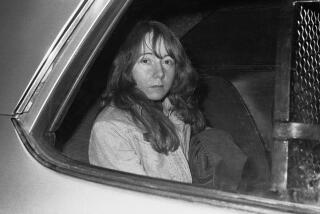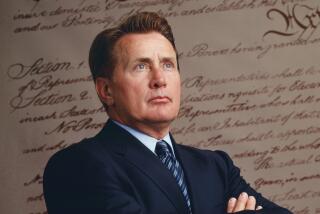MOVIES : FILM COMMENT :...
Broken down to its most elemental parts, the movie is driven by the coldblooded assassination of a charismatic American figure, a handsome visionary cut down in his 40s by a killer or killers who never stood trial and who may, in fact, still be at large. In re-enacting that historical event, the filmmaker has taken great liberties with known facts, tailoring real-life characters and situations to suit his own dramatic purposes.
Whether people find that kind of “poetic license” appropriate in film seems to depend these days on which picture they’re discussing: Oliver Stone’s “JFK” or . . . Barry Levinson’s “Bugsy.”
“Bugsy,” about the Hollywood years and ambush slaying of mobster Bugsy Siegel, is as much a blend of fact and supposition as “JFK,” which examines the death of President John F. Kennedy. Yet, no one has freaked out over the authenticity of “Bugsy.” No one has jumped down Levinson’s throat for promoting the falsehood that Siegel invented modern Las Vegas, or quizzed him about the decision to write Siegel’s family out of his Hollywood life. In their reviews, most critics were loath to even mention the film’s factual transgressions.
Of course, Bugsy Siegel--to lift a phrase--was no John Kennedy. He was a coldblooded killer himself, so who cares who bumped him off? Certainly not Levinson or screenwriter James Toback. They just made him over in the image of Warren Beatty and asked us to suspend our disbelief for a couple of hours and enjoy him.
Stone doesn’t want us to suspend our disbelief for a second. He wants us as clearheaded jurors to rule on a mountain of evidence he believes will convict a horde of conspirators for killing the President. Its style is part documentary, part cinema verite , part history warmed-over, part invention and 100% earnest speculation.
Setting aside the relative importance of their subjects, the approaches to “Bugsy” and “JFK” raise some interesting questions. When is the line between artistic license and social responsibility crossed? When does a movie cease being entertainment and become propaganda? And should such distinctions even be made in a society that covets free expression?
The anger that has been directed at Oliver Stone by “I was there” journalists, politicians and others recalls the criticism of Michael Moore’s “Roger & Me,” a 1989 filmed put-down of General Motors Chairman Roger Smith. That quasi-documentary was a wryly acerbic indictment of the corporate mentality. The film’s effectiveness owed as much to Moore’s dubious rearrangement of fact as to Smith’s immense insensitivity.
When some of Moore’s techniques were revealed, after the film had been released and heralded as a masterpiece, many people felt betrayed. Pauline Kael of the New Yorker accused Moore of breaking faith with those viewers who might reasonably trust a documentary to deal in fact. Moore and his critic-defenders argued that the substance of the film was true and that he had merely moved things around to help focus his portrait.
“Roger & Me” was an extraordinary film achievement, and “JFK” may be Stone’s most technically brilliant movie. At the same time, both films do break faith with their viewers. Filmmakers have a tacit responsibility not to lie or distort truth when truth is the very thing they claim to present. You cannot ask people to trust you, then deceive them--even if you believe it’s for their own good. Isn’t that exactly the kind of governmental lying and covering up that Stone is deploring in “JFK”?
For the thousands of GM workers that Roger Smith put out of work in the ‘80s, he was the Grinch who stole Christmas and he had it coming to him in “Roger & Me.” But his comeuppance, his humiliation at Moore’s hands, would have been much easier to relish if the film hadn’t contained bogus evidence.
Stone, like Moore, has made “the right of the artist to interpret history” the keystone of his defense for “JFK,” yet the movie hardly qualifies as an artistic interpretation of history. It is a legal case, with prosecuting attorney Stone attempting to prove two things: that the Warren Commission was all wet (or worse) when it concluded that Lee Harvey Oswald acted alone in killing Kennedy, and that the assassination was carried out as part of an elaborate coup d’etat that went all the way to the vice president’s office in the White House.
Like numerous conspiracy theorists before him, Stone seems to win the first argument. In light of known facts repeated in the movie, the lone-gunman theory is almost impossible to accept. But it’s still easier to swallow than the everyone-was-in-on-it scenario. While condemning the Warren Commission members, newspaper reporters and others for accepting unreliable evidence, Stone grasps every odd detail and coincidence that works into his argument.
In “Crossfire,” one of the two books Stone optioned for “JFK,” author Jim Marrs tells about a man who had a seizure in front of the Texas School Book Depository a few minutes before Kennedy’s motorcade arrived in Dealey Plaza.
In the movie, the man’s seizure is re-enacted and proposed as a decoy in the assassination plot. We’re told by Kevin Costner’s all-knowing Jim Garrison that the man disappeared after the ambulance hauled him away. In the book, the seizure victim explains that he was taken to Parkland Hospital and walked out before being treated because the entire emergency room staff had been called to more urgent business (Kennedy had arrived).
Stone doesn’t need to appeal to the artist’s rights as a defense of “JFK”; his right to express his opinions is covered by the First Amendment, and it is opinion, not history, that he has so effectively dramatized.
“Bugsy” is an example of an artist interpreting history, of molding people and events and a period to create an impression; “JFK” is an example of an artist exorcising his politics, of stylizing the techniques of debate to make his arguments.
Much of the Op-Ed furor over “JFK” is overwrought and self-serving. Everybody who was in Dealey Plaza on Nov. 22, 1963, seems to feel a historical mandate to retell the events as he or she saw them. Every newsperson who came to accept the Warren Report seems to believe that his or her integrity has been challenged. People with open minds are avoiding seeing the movie for fear of coming out “unclean.”
Stone has said his greatest hope with “JFK” is that it will bring pressure on the government to unseal documents not scheduled for public scrutiny until the year 2029. The worst-case scenario of some detractors is that young people seeing the movie will become cynical about their government. If either of those things result, “JFK” should be up for public service awards, if not the Oscars.
Whatever people think of “JFK” or its view of the Kennedy assassination, it’s a provocative piece of filmmaking, and the debates over it have been a refreshing break from the “sex lives of the rich and famous” approach that passes for news these days.
In a year when people actually wondered who touched their genitals in a video most, Madonna or Michael Jackson, and when Liz Taylor’s umpteenth marriage was upstaged in society news only by Warren Beatty’s impregnation of Annette Bening, Stone’s contribution was no less than heroic.
But for the sake of viewers, “JFK” would have been a more honorable effort if it had come with the same kind of warning label that Jim Marrs inserted as the very first sentence of “Crossfire.”
“Do not trust this book,” he said.
That goes double for the movie.
More to Read
Only good movies
Get the Indie Focus newsletter, Mark Olsen's weekly guide to the world of cinema.
You may occasionally receive promotional content from the Los Angeles Times.










